RC Celta de Vigo travelled to the south of Spain to the Ramon Sanchez-Pizjuan Stadium where they took on Sevilla FC. The Andalusian club under Julen Lopetegui enjoyed a positive start to the season with wins over Espanyol and Granada in their opening games moving them to the top of the La Liga table. Celta faced a stiff opener against Real Madrid, but looked strong after their upset of Valencia. In this tactical analysis we see how these two teams clashed in a very interesting battle of tactics with the game culminating in a stalemate.
Lineups
Sevilla shaped up in Lopetegui’s traditional 4-3-3 formation sticking with the defensive partnership of Daniel Carriço and Diego Carlos at the back, despite Carlos’ minor injury in the past week. The pace on the flanks was provided by Sergio Reguilón on the left and Jesús Navas on the right. Fernando Reges organised the buildup between Carriço and Carlos and act as the central pivot. Éver Banega and Joan Jordan drove the midfield in the centre filling spaces left by the overlapping fullbacks. Luuk de Jong played the target man up top, while Nolito provided the attacking threat on the left establishing his rising chemistry with Reguilón since the beginning of this season. Lucas Ocampos was rested after utilising him for 90 minutes against Granada despite his injury. Hence the attacking responsibility on the right fell on the shoulders of ex-Barca man, Munir El Haddadi.
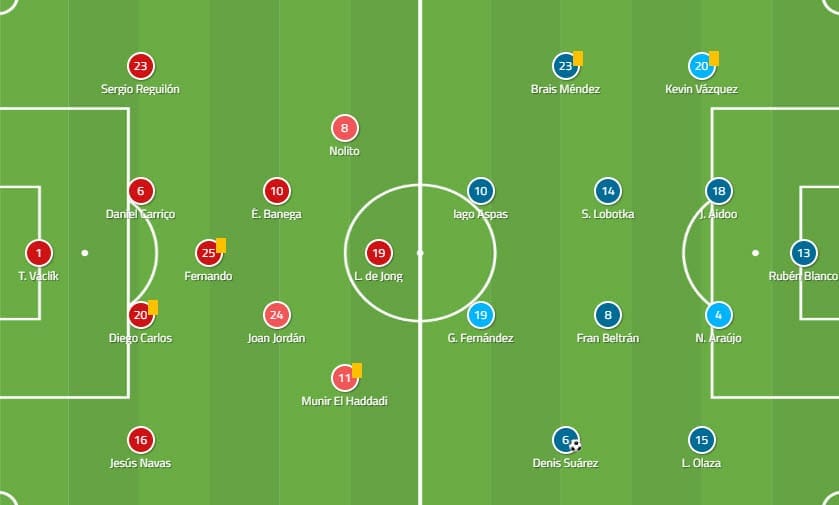
Celta de Vigo played a 4-4-2 with the combination of Gabriel Fernández and Iago Aspas at the front. Brais Méndez and Denis Suárez played as the wide midfielders who were tasked of breaking into central areas and overload the Sevilla midfield in attacking phases while Stanislav Lobotka and Fran Beltran formed a two-man central midfield partnership. At the back, it was the job of Kevin Vazquez, Joseph Aidoo, Néstor Araujo and Lucas Olaza to hold the line and absorb and contain this Sevilla attack at the Sanchez-Pizjuan.
Story of the stats
The game could be broken down into four phases. Sevilla’s strategy was to spend the first 20 minutes engaging in a high-octane pressing starting well into Celta’s half putting a lot of pressure upon their backline. They would also aggressively counter-press upon losing the ball and continue keeping possession in wide areas after winning it back. This strategy worked quite effectively. Although throughout the game, Sevilla had 63% possession, in the first 20 minutes they held a whopping 83.6% possession registering 9 shots on target and completing 161 of their 519 total passes during the game.

However it was a dry day of late summer in Andalusia with temperatures close to 30 degrees Celsius and mandating drinks break. Hence it was understood that Sevilla could only keep up such a high-pressing game for about 20 minutes. Failing to score early, which was clearly Lopetegui’s plan, following the break in the first half, Sevilla calmed down and allowed Celta more time on the ball to organise themselves. Thus for the rest of the first half, possession stats were a lot more even for both teams.
The start of the second half saw the visitors undertake more positional tactics in their attacking phase with the forwards showing greater participation in the build-up. Celta brought on Santi Mina, a forward easily capable of playing in wide positions or regularly drop into midfield akin to Iago Aspas. This made them more dynamic in the middle and we saw Celta complete 6 dribbles out of 8 attempted until the final quarter hour.
The final 15 minutes was the most dramatic with both teams making tactical changes that brought immediate results. Sevilla managed to open the scoring with the substitute Franco Vázquez from a set piece by Banega. As a fitting response, from the restart of the game, Celta went on a streak of 15 passes only giving away possession for 3 seconds before equalising in a dramatic goal by Suárez. We saw Celta come back with character, although giving away possession six times in these minutes still managing to win the ball back aggressively with four interceptions and five clearances. In order to dissect the events behind, a closer tactical analysis of both teams is needed.
Sevilla’s attacking organisation
Sevilla stuck to traditional positional tactics in their two objectives during attack: width in possession and immediate pressure upon losing the ball. We saw their 4-3-3 transform into a 3-2-4-1. During the first 20 minutes, they also maintained a rather high line as part of their aggressive strategy to pick up an early lead.
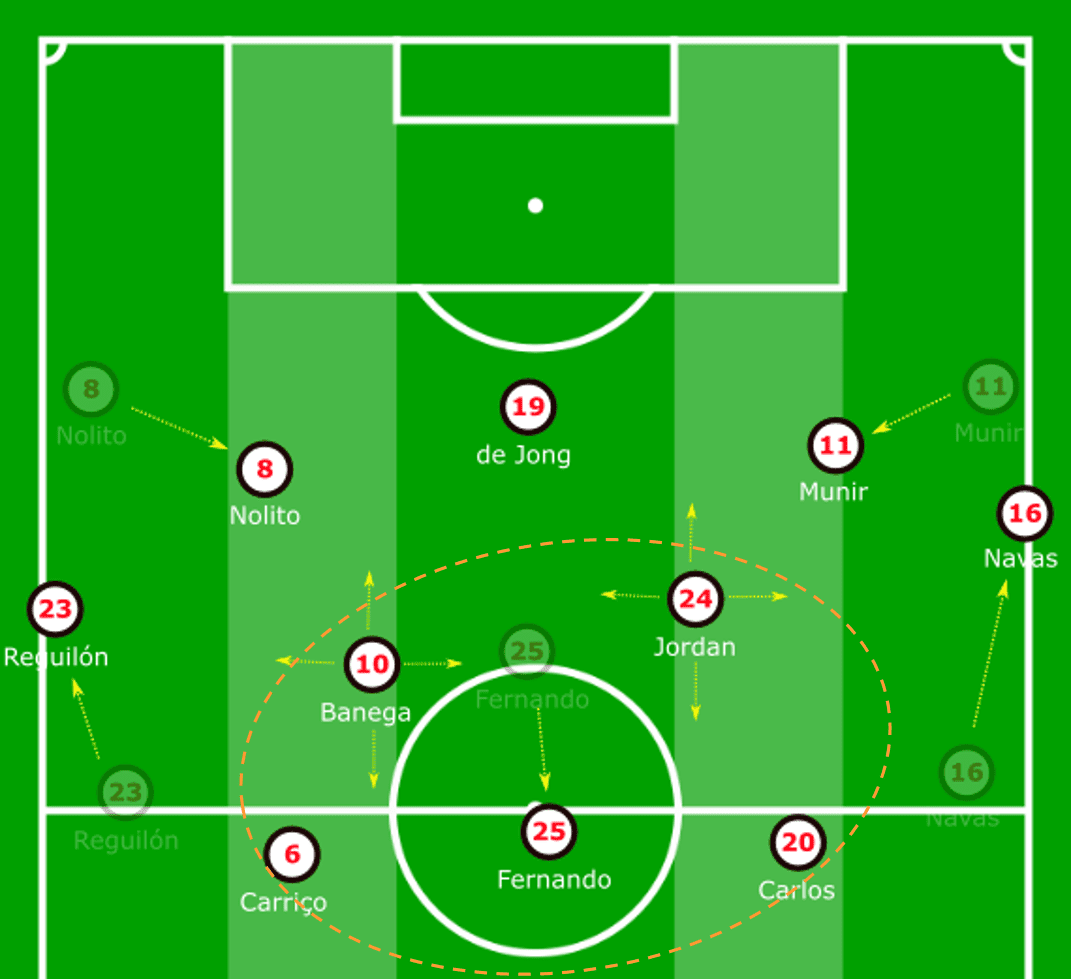
As the central defensive pair split wide to occupy the half spaces, Fernando dropped in between them as a deep lying midfielder. Banega and Jordan would work constantly in front of this line of three closing the spaces as covering plenty of real estate to maintain ball circulation from deep areas. Reguilón and Navas were tasked at maintaining width by moving up the wide channels. From wide areas they constantly sought for the target man de Jong with early crosses into Blanco’s six-yard box.

Staying high up not only allowed a midfielder like Banega with sublime vision to switch play with ease and move Celta’s 4-4-2 block from width-to-width, it also provide a lot of support to the forwards who occupied the central corridors between the channels of the defensive line pinning them back. The deeper positions and dynamic rotations in the middle shown by the midfield-trio gave the positional freedom to the fullbacks to stay high without risk of a counter attack behind them, as there were still five players to cover defensively and counterpress in central areas if the ball was lost.
As a result we saw certain rehearsed passages of play from Lopetegui’s side to maintain possession in the attacking phase in such a dominant fashion: Banega would constantly seek Navas with the cross-field diagonal ball to switch sides. Reguilón and Nolito would capitalise on their partnership and understanding of each other’s game to break the defensive line with quick combinations between each other. Jordan would look to form passing triangles with de Jong and Munir playing between the lines of the Celta defence to split them apart. Despite creating chances however, Sevilla lacked clinical finishing in front of goal to convert per Lopetegui’s strategy to steal an early goal.
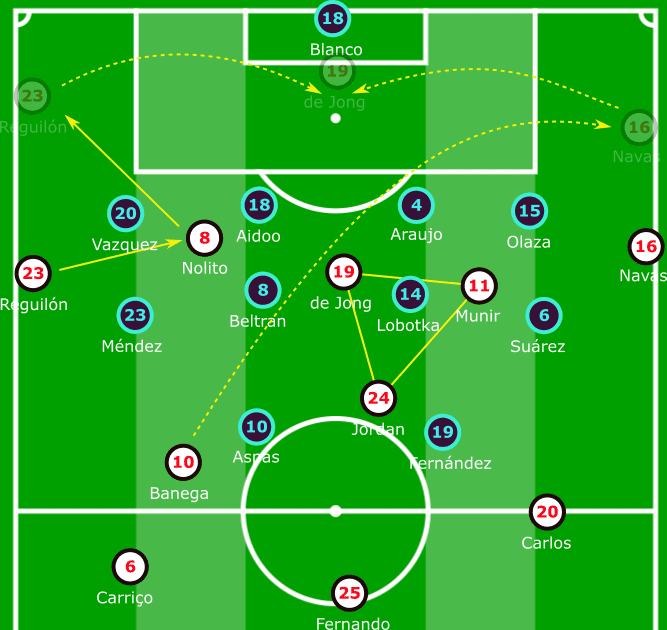
How did Celta cope with this in the first half?
The ultra-high press from the hosts rattled Celta early on with the visitors only managing 16.4% possession. The natural response from the team’s 4-4-2 organisation was to sit in a deep block and absorb the overwhelming quarry of attacks piled upon by Sevilla. The high press made it impossible to play out from the back. Recognising Aidoo as the centre back who was more inclined to make errors, the press was more aggressive when Blanco played the ball out to the right. As a result, the ball returned to him and he was forced to launch it back into midfield where it was quickly recovered by the opposition.

Once Sevilla eased on the press after the drinks break, Fran Escribá was able to switch his tactics to help them keep possession more effectively. Celta’s big advantage was the versatility of their forwards. Playmakers like Aspas are capable of more than simple waiting up top for the long ball to them. We saw Aspas break away from his position to drop into deep areas in the midfield to receive the ball and offer passing lanes.
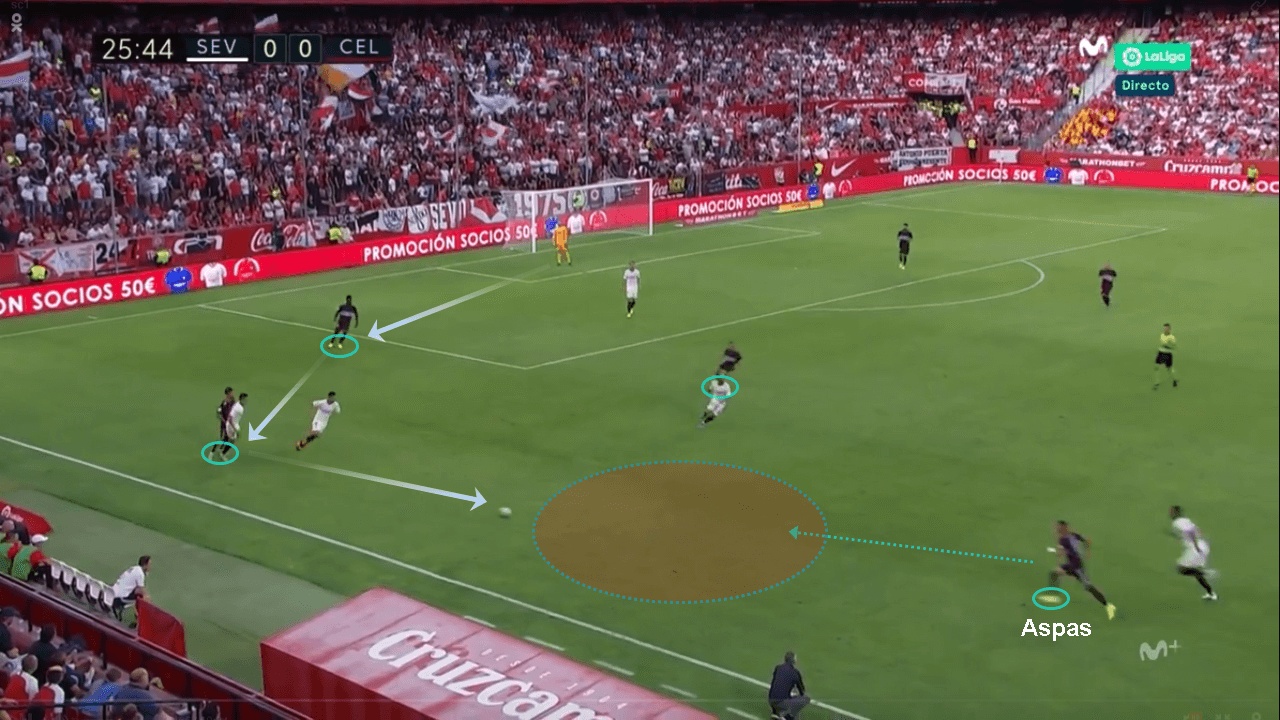
Previously the midfield duo of Lobotka and Beltran were neutralised by the press involving Sevilla’s front three plus one of the two midfielders – Banega or Jordan. But Aspas dropping into midfield balanced out the 3v2 numerical superiority that Sevilla were looking to enforce in the centre. Although Aspas dropped into midfield, Celta still had Fernández and Méndez in advanced positions to link play and carry the attack forward. Fernández was able to pin the defenders back while Méndez and Suárez provided plenty of threat between the lines.
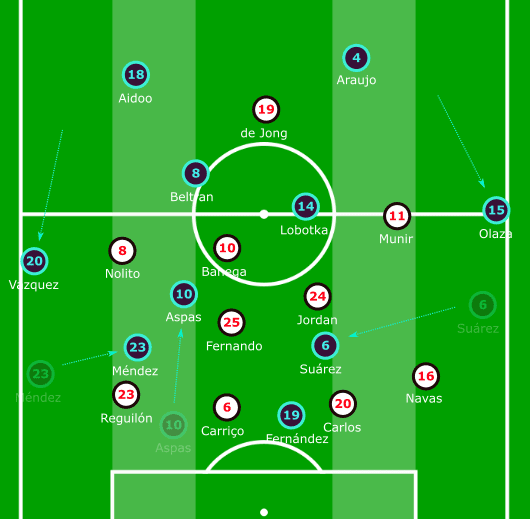
Celta’s strategic use of inverted midfielders
One of the key tactical advantages of Celta that helped them deal with a stronger Sevilla side was the use of wide midfielders who constantly drifted into spaces in the centre. This helped transform an orthodox 4-4-2 formation into a positional one with plenty of rotations involving the versatile forwards of Celta. With wide players and forwards drifting inside, they cancelled out the numerical superiority in the middle while maintaining width using the fullbacks and gained a lot of control in their attacking organisation. A key to this advantage is that the use of a single deep lying pivot by Sevilla meant there were a lot of spaces in front of the defence for the two midfielders Banega and Jordan to cover. Celta were able to exploit these spaces intelligently.
At the helm of this tactic was Denis Suárez. Already holding a rich experience at Barcelona in the midfield and then at loan at Arsenal, Suárez was the perfect man to fit into this role of an inverted midfielder. Starting off from the wide position, he would break inside behind the lines of Sevilla’s pressure. A prime pillar of positional play is to always have numerical superiority behind lines of opposition pressure. Dropping into this space between the lines meant he was incredibly difficult to mark yet he would always form a passing lane for his defenders while coming out from the back. A look at his touchmap in this game gives us a better idea of how he controlled central areas, especially the left half space for Celta from which he was a vital link between the midfield and the attack.
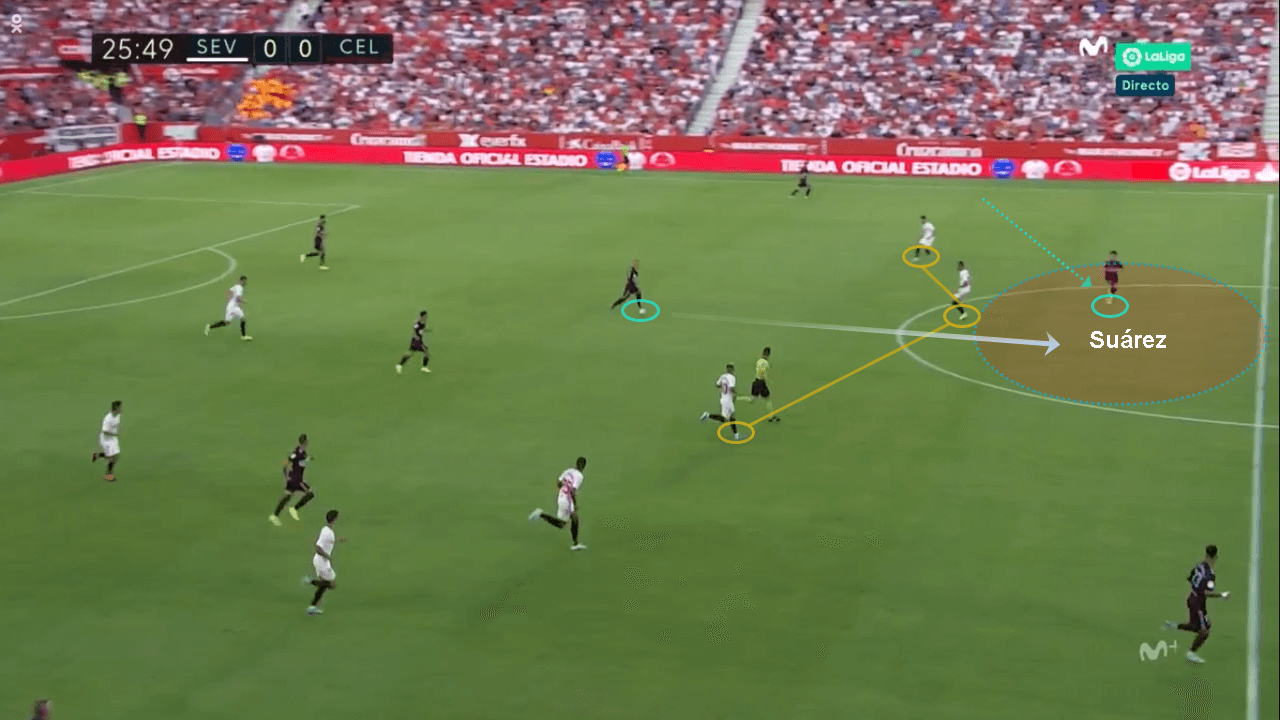
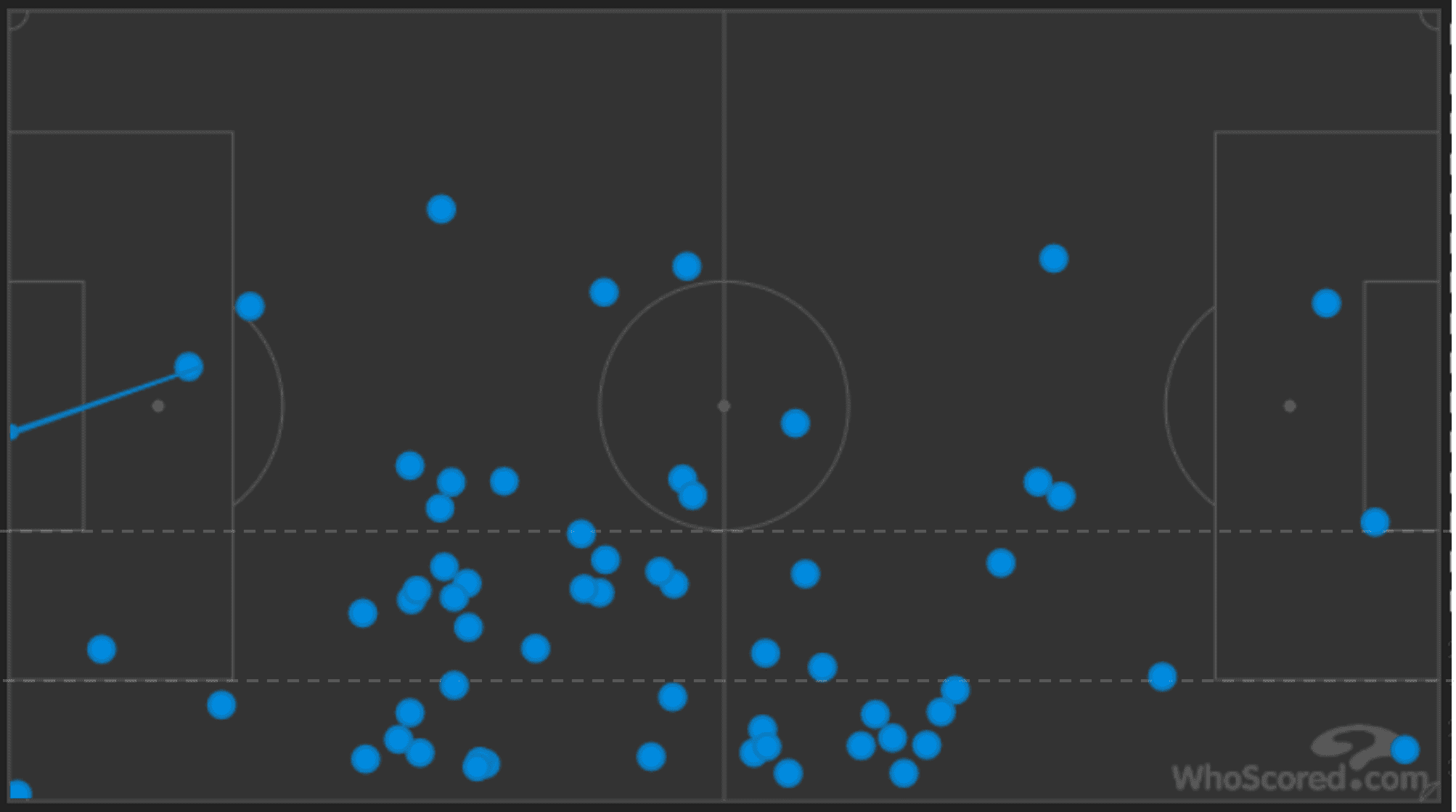
Thus we saw Celta come back much stronger in the second half. Sevilla were able to score first after Lopetegui brought off Munir for Bryan Gil for a different dynamic on the right wing, and Franco Vázquez for Joan Jordan for a more physical presence in the centre, but they could not hold on to the lead for long.
Celta’s equalising goal – a work of art
While Lopetegui brought on Gil in place of Munir for a fresh vitality in the Sevilla attack around the hour mark, Escribá brough on Santi Mina for Fernández to do the same for Celta. Mina, like Aspas was very dynamic in his positional game by frequently dropping into spaces and receiving the ball from deep areas. It was Mina’s introduction that saw Celta play man-oriented pressing system with the objective of taking control of the centre. This made it very uncomfortable for Sevilla to build-up with the same ease that they started the game.

The combination of inverted wingers and free roaming forwards resulted in a 4-4-2 morphing into a fluid striker-less system with plenty of players between the lines. The equalising goal can be easily considered the holy grail of Escribá’s tactical genius in this game. In the buildup to the goal we saw plenty of possession in wide areas, taking advantage of the fact that Sevilla would expect to defend their newly gained lead in the final quarter hour of the game. A couple of passes at the back and a long ball seeking Mina from Olaza immediately put pressure on the Sevilla defence. Carlos who was able to secure the ball looked to play it to the keeper Vaclík. With Celta’s man-oriented pressing, Vaclík was forced to launch it long and into the possession of Celta back again.
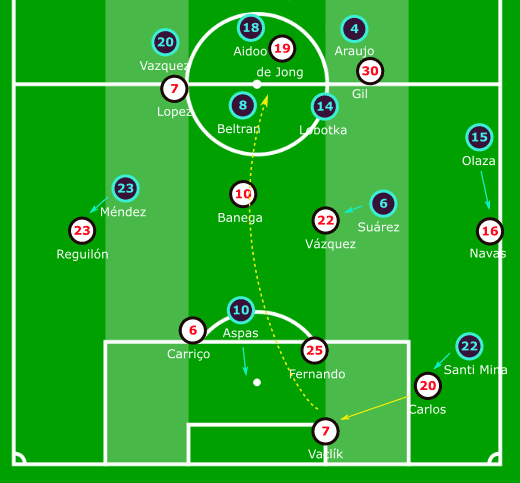
All this while, Suárez occupied free spaces in the centre as the free-man who could combine in triangle passes with Beltran and Lobotka. Mina and Aspas also positioned themselves between the lines. A nifty dribble by Lobotka saw him turn and pivot around two defenders and play a splitting pass accurately to Mina positioned just in front of the Sevilla defence. Mina laid if off to Suárez, who on a third-man combination run with Lobotka, was impossible to mark and managed to neatly convert it for Celta within three minutes of Sevilla taking the lead. This goal had all the tactical elements that Celta used to counter Sevilla in the second half of the game.
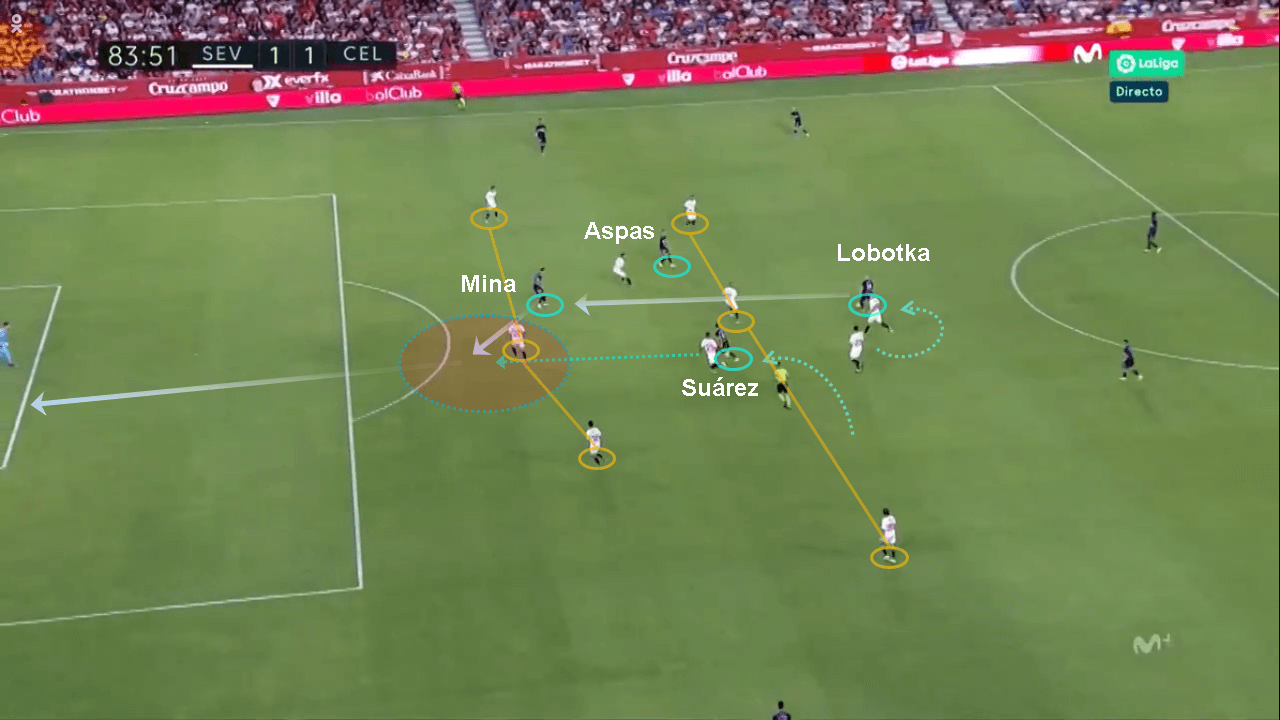
Conclusion
A win for Sevilla would have seen them go comfortably to the top of the table, but Celta managed to tactically restrict them holding them out for a draw. The celebrations at the Sanchez-Pizjuan barely lasted three minutes for the hosts. It is questionable whether going for the high-press so early and then easing off was the right decision by Lopetegui, rather than periodizing the aggressive pressing in a balanced way throughout the 90 minutes. Although Sevilla are capable of playing an extremely attacking system, they lack clinical finishing in front of goal from de Jong and Munir. Perhaps the return of Ocampos would help out, but Lopetegui will seek more depth in his attacking options eventually. Could the latest arrival of Chicharito be the answer?
Celta Vigo, always known for their courageous displays in La Liga lived up to their reputation with a brilliant performance against a strong side. Denis Suárez has been the star man for Celta since the start of the season, and we can only expect his role to diversify as Escribá will be challenged to tactically adapt to other teams in the league. The league is still wide open, with plenty of surprises and upsets and how teams perform in this crucial first part of the season will significantly influence the standings by the end of this year.

If you love tactical analysis, then you’ll love the digital magazines from totalfootballanalysis.com – a guaranteed 100+ pages of pure tactical analysis covering topics from the Premier League, Serie A, La Liga, Bundesliga and many, many more. Buy your copy of the August issue for just ₤4.99 here.

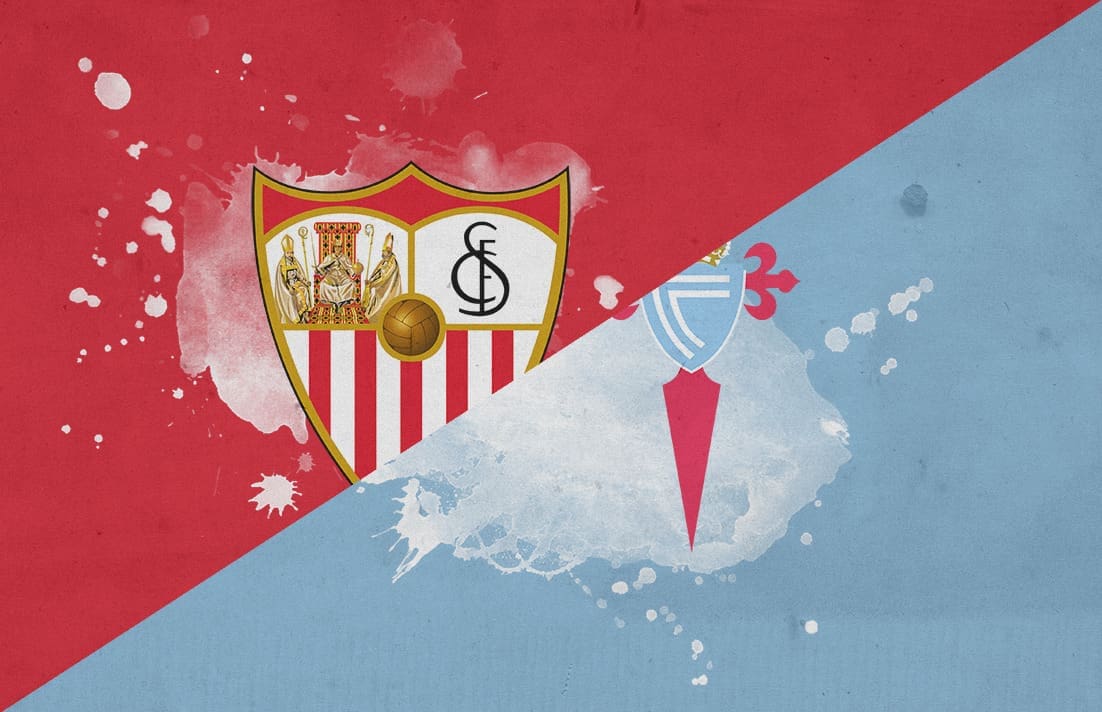



Comments